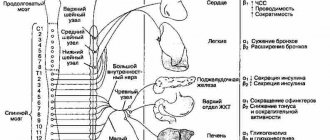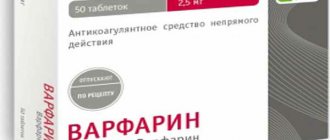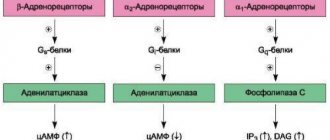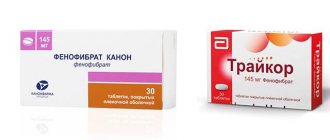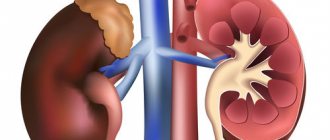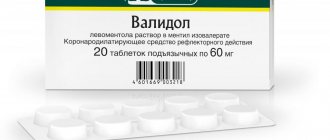High blood pressure needs to be monitored daily. High tonometer readings are the first sign of a risk of developing blood clots and, as a consequence, stroke. Pharmacological companies offer a wide selection of drugs to normalize blood pressure. In order not to harm your own health, it is important to take such medications strictly as prescribed by your doctor.
Normal pressure readings
Everyone should know the status of their blood pressure. High readings are a reason to undergo a detailed examination to find out the reasons for the increase in readings. The upper value indicates the force with which the heart pushes blood through the circulatory system to circulate. And the lower reading is the force with which the blood presses on the walls of blood vessels, returning through the arteries.
Normally, blood pressure values should be close to ideal – 120/80 mmHg. With low blood pressure, these indicators drop to 100/0 mmHg. A slight increase to values of 130/90 mmHg. may indicate excitement or temporary overexcitement. But if the tonometer never shows numbers less than 130/90, you need to consult a doctor.
Age has an impact on blood pressure levels. For example, the younger a person is, the lower his standard. For older patients, slight increases in values are acceptable. High blood pressure is called hypertension.
Symptoms
Symptoms that may indicate increased blood pressure include:
- headache;
- dizziness;
- “flies” before the eyes;
- discomfort in the heart area.
If any of them appear, you should measure your blood pressure. If it is higher than normal, you need to take care of reducing it.
Does it happen that nothing bothers a person, but his blood pressure is elevated? Unfortunately, such cases are not uncommon. This is why it is so important to control your blood pressure even when you feel normal. Many people mistakenly think that if there are no symptoms, then there is no need to reduce blood pressure. Indeed, why take pills if you feel good? Alas, the frequency of complications of hypertension does not depend on whether you feel it or not.
Hypertension can cause serious complications.
Dangerous complications:
- myocardial infarction;
- stroke;
- renal failure.
The higher the pressure, the greater the risk of their development.
Categories of medications for normalizing blood pressure
All medications that can normalize blood pressure and relieve attacks of hypertension can be divided into several categories:
- Beta blockers. Such medications affect the heart rhythm, reducing its frequency. Not every hypertensive patient can use such drugs. This is especially true for those whose normal rhythm does not exceed 60 beats per minute.
- ACE inhibitors. Such medications are indicated for those who have high blood pressure due to excess production of hormones that affect vasoconstriction. Drugs are ways to reduce the production of hormones, the action of which reduces the lumen of the circulatory system.
- Diuretics. These medications directly affect kidney function. People call them diuretics. Some patients report sudden weakness and dizziness after taking one tablet. Such drugs should not be taken in long courses. They are used to relieve swelling. Frequent use of diuretics may cause seizures.
- Calcium antagonists. Such agents have a relaxing effect on the walls of blood vessels, due to which they expand and pressure decreases. Treatment with calcium antagonists may cause dizziness.
Only a complete diagnosis can give an accurate answer as to which drug should be used to reduce blood pressure in each specific case. Self-administration of medications that affect blood pressure is unacceptable.
RAAS: the basics
Before we begin describing the drugs, let’s dive briefly into the intricacies of pharmacology and once again remember what the mechanism of action of the renin-angiotensin-aldosterone system, or RAAS, is.
The RAAS is a complex hormonal-enzymatic system in which almost all organs and tissues of the body are involved, but the key roles in it belong to the liver, kidneys, adrenal glands and lungs.
Alpha-2‑globulin angiotensinogen is constantly synthesized in the liver. At the same time, the kidneys produce the enzyme renin in response to decreased intrarenal pressure, decreased delivery of sodium and chloride, and hypoxia. It enters, like angiotensinogen, into the systemic circulation, where it binds to it to form angiotensin I.
Angiotensin I is a practically inert substance. It does not act on blood vessels and is only a precursor of the active component angiotensin II. In the formation of the latter, along with angiotensin I, angiotensin-converting enzyme (ACE), which is produced in the lungs, is involved.
Angiotensin II is the main link in the RAAS circuit.
It exhibits a powerful vasoconstrictor effect and affects the target organs in which its receptors are located. First of all, we are talking about the endothelium, heart and kidneys. This is why high levels of angiotensin II are associated not only with increased blood pressure, but also with damage to the vascular wall, myocardium, kidneys, and the development of chronic heart and kidney failure.
In addition, angiotensin II causes increased synthesis of the adrenal hormone aldosterone. The latter is involved in the control of blood pressure (BP) by regulating the homeostasis of potassium, sodium and intracellular fluid volume. Under its influence, blood pressure increases and the sensitivity of vascular smooth muscles to vasoconstrictor substances, including angiotensin II, increases.
Thus, the RAAS is directly involved in the drama called “arterial hypertension”, playing one of the main roles in it. Fortunately, it is possible to block this system. This can be done with drugs of two pharmacological groups - angiotensin-converting enzyme inhibitors (ACEIs) and angiotensin II receptor blockers (ARBs, also known as sartans).
Lisinopril is a safe drug
Lisinopril belongs to the category of ACE inhibitors. However, it also contains a substance belonging to the group of diuretics. This drug is often prescribed to elderly patients who suffer from hypertension. It is approved for use in diabetics, since the composition of the drug does not affect blood glucose levels in any way.
The effect of a single dose of the tablet is noted by the patient after an hour, and its effect persists throughout the day. The main functions of Lisinopril include:
- increasing the ability of the heart to withstand loads in conditions of acquired failure;
- reducing the risk of developing pathologies of the heart muscle;
- maintaining pressure within normal limits;
- assistance in stabilizing the condition of patients with diabetes.
The main side effects are non-dangerous conditions:
- feeling of dry mouth;
- rare cough;
- increased sweating;
- slight dizziness.
If dizziness or cough interferes with normal functioning, you should inform your doctor about this so that the drug can be changed.
ACE inhibitors: remember by name
Let's consider the features of some drugs - representatives of the ACE inhibitor group.
- Captopril is the first non-peptide ACEI, synthesized in 1975 [2]. The only tableted ACEI used to relieve hypertensive crisis. The dose is prescribed by the doctor (12.5–50 mg).
- Lisinopril is the only hydrophilic ACEI that does not accumulate in adipose tissue. Therefore, it is recommended for hypertension against the background of excess body weight and metabolic syndrome [2].
- Ramipril is an ACE inhibitor, which in a randomized trial demonstrated a significant reduction in overall mortality from CVD in high-risk patients by 16%, mortality from myocardial infarction by 20%, from stroke by 32%, and from chronic heart failure by 23% [ 6]. In addition, the incidence of new cases of diabetes while taking ramipril was 33% lower than in the placebo group [7].
- Fosinopril is an ACE inhibitor that is suitable for patients with hypertension due to severe renal failure, since it is eliminated in two interchangeable ways: through the liver and kidneys.
- Enalapril is the only ACEI that has a parenteral form (the active metabolite of enalapril is enalaprilat). Enalaprilat, like captopril, is used to relieve hypertensive crisis.
- Zofenopril is one of the most lipophilic ACE inhibitors. Due to its high lipophilicity, it easily penetrates into organs and tissues, showing a special affinity for the heart and blood vessels. It has a long-term anti-ischemic and cardioprotective effect, and exhibits an antioxidant effect [8].
- Spirapril has a long half-life, which provides a long-lasting and uniform antihypertensive effect. Does not require dose titration [9].
- Quinapril has high tissue specificity - it suppresses ACE in the plasma, lungs, kidneys, heart, and vascular walls. Improves the function of the vascular endothelium, providing an antiatherosclerotic effect [10].
Physiotens - a medicine with a minimum of side effects
Physiotens has a minimum of side effects. The most unpleasant symptoms include dry mouth and possible drowsiness. But most often it is possible to keep the pressure normal without side effects, or they are mild, which a hypertensive patient may not even be aware of.
Another feature of Physiotens is that it is approved for use in patients with bronchial asthma. In addition, the components included in the composition increase sensitivity to the hormone insulin. This means that the drug can be prescribed to patients with diabetes.
The main active ingredient here is moxodinine.
Sources
- Zadionchenko V.S., Shekhyan G.G., Timofeeva N.Yu., Shchikota A.M., Yalymov A.A. Features of combined antihypertensive therapy in the modern treatment of arterial hypertension // Breast Cancer. 2011. T.19. No. 26. pp. 1630–1639.
- Messerli FH, Williams B, Ritz E. Essential hypertension. Lancet. 2007 Aug 18;370(9587):591-603. doi: 10.1016/S0140-6736(07)61299-9. PMID: 17707755.
- Dickson ME, Sigmund CD. Genetic basis of hypertension: revisiting angiotensinogen. Hypertension. 2006 Jul;48(1):14-20. doi: 10.1161/01.HYP.0000227932.13687.60. Epub 2006 Jun 5. PMID: 16754793.
- Haslam DW, James WP. Obesity. Lancet. 2005 Oct 1;366(9492):1197-209. doi: 10.1016/S0140-6736(05)67483-1. PMID: 16198769.
- Byrd, James Brian; Ram, C. Venkata S.; Lerma, Edgar V. (2019). "Pharmacologic treatment of hypertension." Nephrology Secrets. Elsevier. pp. 477–482. doi:10.1016/b978-0-323-47871-7.00078-2. ISBN 978-0-323-47871-7. ACE inhibitors inhibit the conversion of angiotensin I to angiotensin II, thereby producing vasodilation and lowering BP. Because the hydrolysis of bradykinin is also inhibited by these drugs, cough (7% to 12%) can occur.
- Felizola SJ, Maekawa T, Nakamura Y, Satoh F, Ono Y, Kikuchi K, Aritomi S, Ikeda K, Yoshimura M, Tojo K, Sasano H. Voltage-gated calcium channels in the human adrenal and primary aldosteronism. J Steroid Biochem Mol Biol. 2014 Oct;144 Pt B:410-6. doi: 10.1016/j.jsbmb.2014.08.012. Epub 2014 Aug 23. PMID: 25151951.
Losartan: can it be taken for blood pressure?
Losartan belongs to the category of sartans. The drug blocks enzymes that can cause vasoconstriction. A single dose becomes noticeable after 40 minutes, and the positive effect lasts throughout the day.
There are no contraindications for use by patients with diabetes. The main components are losartan potassium and hydrochlorothiazide. The substances complement each other, enhancing the therapeutic effect. Godrochlorothiazide is a diuretic, which speeds up relief from an attack of hypertension.
Non-drug treatments for hypotension
It is possible to increase blood pressure without medications to some extent, and this measure is purely individual. It is important to walk in the fresh air more often, at least an hour a day, and for pregnant women - at least an hour in the morning/afternoon and an hour in the evening. Sports or physical activity stimulates blood circulation, and accordingly, blood pressure normalizes. Although it is known that professional athletes have slightly lower blood pressure levels than other people.
If you notice problems with blood pressure, it will be useful to take a contrast shower in the morning (alternate cold and hot water). This procedure has its own characteristics, which we will not describe here. To normalize blood pressure, proper nutrition is important. During fasting, the body begins to save resources, temperature and pressure decrease. Sleep should be at least 8 hours a day for teenagers and adults. You should also avoid overwork, both mental and physical equally. Alternate mental and physical activities.
Captopril for high blood pressure
Captopril belongs to the group of ACE inhibitors and allows you to quickly reduce high blood pressure to normal values. The minimum of side effects makes taking the drug safe and accessible to most hypertensive patients.
One feature of the drug is the activity of the composition. This is why Captopril is not used for a long time. If the doctor prescribes the drug for a long course, the patient will soon notice a decrease in blood pressure below normal levels.
What pills are allowed to be taken during a hypertension crisis?
How to quickly reduce blood pressure with pills in the event of a hypertensive crisis? To stop it the following are used:
| Drugs | Medication features and dosage |
| Nitroprusside | |
| Phentolamine | |
| Moxonidine | |
| Prazosin | |
| Magnesium sulfate | |
| Apressin |
